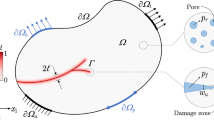Abstract
A new formulation of the boundary element method (BEM) is proposed in this paper to calculate stress intensity factors for cracked 2-D anisotropic materials. The most outstanding feature of this new approach is that the displacement and traction integral equations are collocated on the outside boundary of the problem (no-crack boundary) only and on one side of the crack surfaces only, respectively. Since the new BEM formulation uses displacements or tractions as unknowns on the outside boundary and displacement differences as unknowns on the crack surfaces, the formulation combines the best attributes of the traditional displacement BEM as well as the displacement discontinuity method (DDM). Compared with the recently proposed dual BEM, the present approach doesn't require dua elements and nodes on the crack surfaces, and further, it can be used for anisotropic media with cracks of any geometric shapes. Numerical examples of calculation of stress intensity factors were conducted, and excellent agreement with previously published results was obtained. The authors believe that the new BEM formulation presented in this paper will provide an alternative and yet efficient numerical technique for the study of cracked 2-D anisotropic media, and for the simulation of quasi-static crack propagation.
Similar content being viewed by others
References
M.D. Snyder and T.A. Cruse, International Journal of Fracture 11 (1975) 315–328.
P. Sollero and M.H. Aliabadi, International Journal of Fracture 64 (1993) 269–284.
P. Sollero, M.H. Aliabadi and D.P. Rooke, Engineering Fracture Mechanics 49 (1994) 213–224.
S.L. Crouch and A.M. Starfield, Boundary Element Methods in Solid Mechanics, George Allen and Unwin Publishers, London (1983).
H.K. Hong and J.T. Chen, Journal of Engineering Mechanics 114 (1988) 1028–1044.
L.J. Gray, L.F. Martha and A.R. Ingraffea, International Journal for Numerical Methods in Engineering 29 (1990) 1135–1158.
A. Portela, M.H. Aliabadi and D.P. Rooke, International Journal for Numerical Methods in Engineering 33 (1992) 1269–1287.
S. Guimaraes and J.C.F. Telles, Engineering Analysis with Boundary Elements 13 (1994) 353–363.
N.N.V. Prasad, M.H. Aliabadi and D.P. Rooke, International Journal of Fracture 66 (1994) 255–272.
N.N.V. Prasad, M.H. Aliabadi and D.P. Rooke, International Journal of Fracture 66 (1994) R45-R50.
S.G. Lekhnitskii, Theory of Elasticity of an Anisotropic Body, Holden Day, San Francisco (1963).
J.D. Eshelby, W.T. Read and W. Shockley, Acta Metallurgica 1 (1953) 251–259.
A.N. Stroh, The Philosophical Magazine 7 (1958) 625–646.
Z. Suo, Proceedings of the Royal Society (London), A427 (1990) 331–358.
E. Pan and B. Amadei, Journal of Engineering Mechanics 120 (1994) 97–119.
T.A. Cruse, in Developments in Boundary Element Methods-P.K Banerjee and R. Butterfield (eds.), Applied Science Publishers Ltd., London (1979).
D.F. Paget, Numerische Mathematik 36 (1981) 447–453.
A.M. Linkov, Acta Mechanica 105 (1994) 189–205.
E. Pan, Acta Mechanica 87 (1991) 105–115.
E. Pan and B. Amadei, Applied Mathematical Modelling 20 (1996) 114–120.
M. Cerrolaza and E. Alarcon, International Journal for Numerical Methods in Engineering 28 (1989) 987–999.
J. Hildenbrand and G. Kuhn, International Journal for Numerical Methods in Engineering 36 (1993) 2939–2954.
G. Tsamasphyros and G. Dimou, International Journal for Numerical Methods in Engineering 30 (1990) 13–26.
A.H. Stroud and D. Secrest, Gaussian Quadrature Formulas, Prentice-Hall, Inc., Englewood Cliffs, N.J. (1966).
Y. Sato, M. Tanaka and M. Nakamura, Engineering Analysis with Boundary Elements 1 (1984) 200–205.
J.R. Rice, Journal of Applied Mechanics 35 (1968) 379–386.
S.J. Chu and C.S. Hong, Engineering Fracture Mechanics 35 (1990) 1093–1103.
M.H. Aliabadi and D.P. Rooke, Numerical Fracture Mechanics, Computational Mechanics Publications, Southampton, and Kluwer Academic Publishers, Dordrecht (1991).
M. Abramowitz and I.A. Stegun, Handbook of Mathematical Functions, Dover Publications, Inc., New York (1972).
H. Mews, Proceedings of the 9th International Conference on Boundary Element Method, C.A. Brebbia, W.L. Wendland and G. Kuhn (eds.), 2 (1987) 259–278.
G.C. Sih, Handbook of Stress-Intensity Factors, Lehigh University, Bethlehem, Pennsylvania (1973).
Y. Murakami, Stress Intensity Factors Handbook, Pergamon Press, Oxford (1987).
K.R. Gandhi, Journal of Strain Analysis 7 (1972) 157–162.
Author information
Authors and Affiliations
Rights and permissions
About this article
Cite this article
Pan, E., Amadei, B. Fracture mechanics analysis of cracked 2-D anisotropic media with a new formulation of the boundary element method. Int J Fract 77, 161–174 (1996). https://doi.org/10.1007/BF00037235
Received:
Accepted:
Issue Date:
DOI: https://doi.org/10.1007/BF00037235




